Impacts of Mining and Urbanization on the Qin-Ba Mountainous Environment, China
Abstract
:1. Introduction
2. Materials and Methods
2.1. Study Area
2.2. Data Collection and Analysis
3. Results and Discussion
3.1. Mining in the Qin-Ba Mountainous Area
3.2. The Impact of Mining on the Ecological Environment
3.2.1. Lead-Zinc Mining in Fengxian County, Shaanxi Province
3.2.2. Phosphate Mining in Baokang County, Hubei Province
3.3. Urbanization in the Qin-Ba Mountainous Area
3.4. The Effects of Urbanization on Ecological Environment
3.4.1. The Expansion of Shiyan City
3.4.2. Construction of the Shennongjia Airport
3.4.3. Real Estate Development in Tourism
4. Conclusions
Acknowledgments
Author Contributions
Conflicts of Interest
References
- Keesstra, S.; Maroulis, J.; Argaman, E.; Voogt, A.; Wittenberg, L. Effects of controlled fire on hydrology and erosion under simulated rainfall. Cuad. Investig. Geogr. 2014, 40, 269–294. [Google Scholar] [CrossRef]
- Liang, X.; Zhang, W.; Chen, L.; Deng, F. Sustainable urban development capacity measure—A case study in Jiangsu Province, China. Sustainability 2016, 8, 270. [Google Scholar] [CrossRef]
- Tiwari, P. Land use changes in Himalaya and their impacts on environment, society and economy: A study of the lake region in Kumaon Himalaya, India. Adv. Atmos. Sci. 2008, 25, 1029–1042. [Google Scholar] [CrossRef]
- Li, P.; Qian, H.; Wu, J. Environment: Accelerate research on land creation. Nature 2014, 510, 29–31. [Google Scholar] [CrossRef] [PubMed]
- Xu, X.; Min, X. Quantifying spatiotemporal patterns of urban expansion in china using remote sensing data. Cities 2013, 35, 104–113. [Google Scholar] [CrossRef]
- Huang, D.; Jin, H.; Zhao, X.; Liu, S. Factors influencing the conversion of arable land to urban use and policy implications in Beijing, China. Sustainability 2015, 7, 180–194. [Google Scholar] [CrossRef]
- Zhao, G.; Mu, X.; Wen, Z.; Wang, F.; Gao, P. Soil erosion, conservation, and eco-environment changes in the Loess Plateau of China. Land Degrad. Dev. 2013, 24, 499–510. [Google Scholar] [CrossRef]
- Peng, F.; Quangang, Y.; Xue, X.; Guo, J.; Wang, T. Effects of rodent-induced land degradation on ecosystem carbon fluxes in an alpine meadow in the Qinghai–Tibet Plateau, China. Solid Earth 2015, 6, 303–310. [Google Scholar] [CrossRef]
- Li, L.; Wu, Y. Application of remote-sensing-image fusion to the monitoring of mining induced subsidence. J. China Univ. Min. Technol. 2008, 18, 531–536. [Google Scholar] [CrossRef]
- Malaviya, S.; Munsi, M.; Oinam, G.; Joshi, P.K. Landscape approach for quantifying land use land cover change (1972–2006) and habitat diversity in a mining area in Central India (Bokaro, Jharkhand). Environ. Monit. Assess. 2010, 170, 215–229. [Google Scholar] [CrossRef] [PubMed]
- Zhai, M.; Xu, X.; Jiang, D.; Jiang, X. Remote sensing monitoring of the ecological environment in Wuhai Mining Area since 1979. Remote Sens. Technol. Appl. 2012, 27, 933–940. [Google Scholar]
- Li, N.; Yan, C.; Xie, J. Remote sensing monitoring recent rapid increase of coal mining activity of an important energy base in Northern China, a case study of Mu Us Sandy Land. Res. Conserv. Recycl. 2015, 94, 129–135. [Google Scholar] [CrossRef]
- Hassan, M.M.; Nazem, M.N.I. Examination of land use/land cover changes, urban growth dynamics, and environmental sustainability in Chittagong city, Bangladesh. Environ. Dev. Sustain. 2016, 18, 697–716. [Google Scholar] [CrossRef]
- Wang, S.; Ma, H.; Zhao, Y. Exploring the relationship between urbanization and the eco-environment—A case study of Beijing–Tianjin–Hebei region. Ecol. Indic. 2014, 45, 171–183. [Google Scholar] [CrossRef]
- Gomiero, T. Soil degradation, land scarcity and food security: Reviewing a complex challenge. Sustainability 2016, 8, 281. [Google Scholar] [CrossRef]
- Cao, C. On land development and utilization in mountainous cities in the Western Region of China. Planners 2003, 7, 72–74. [Google Scholar]
- Sun, Z.; Wang, Y.; Chang, J.; Wang, Y. The strategic position of Qin-Ba mountain area in the protection of ecological environment. Environ. Sci. Technol. 2001, 24, 60–61. [Google Scholar]
- Liu, X.; Pan, Y.; Zhu, X.; Li, S. Spatiotemporal variation of vegetation coverage in Qinling-Daba Mountains in relation to environmental factors. Acta Geogr. Sin. 2015, 70, 705–716. [Google Scholar]
- He, J. Experience and problems in ecological environment construction of Qin-ba mountain area. Tangdu J. 2005, 3, 53–57. [Google Scholar]
- Li, N.; Guo, C.; Hui, Z.; Ma, Z. A study on the exploitation and utilization of mineral resources and regional sustainable development in Qinling-Daba Mountain of Southern Shaanxi. Res. Sci. 1999, 21, 31–34. [Google Scholar]
- Weng, Q. Land use change analysis in the Zhujiang Delta of China using satellite remote sensing, GIS and stochastic modelling. J. Environ. Manag. 2002, 64, 273–284. [Google Scholar] [CrossRef]
- Treitz, P.M.; Howarth, P.J.; Gong, P. Application of satellite and GIS technologies for land-cover and land-use mapping at the rural-urban fringe: A case study. Photogramm. Eng. Remote Sens. 1992, 58, 439–448. [Google Scholar]
- SFA. Ecological Protection and Construction Planning of Qin-Ba Biodiversity and Ecological Function Conservation Area; State Forestry Administration of the People’s Republic of China: Beijing, China, 2014. [Google Scholar]
- Wang, S.; Liu, C.; Zhang, H. Suitability evaluation for land reclamation in mining area: A case study of Gaoqiao bauxite mine. Trans. Nonferr. Met. Soc. China 2011, 21, s506–s515. [Google Scholar] [CrossRef]
- Wei, Y.D.; Ye, X. Urbanization, urban land expansion and environmental change in China. Stoch. Environ. Res. Risk Assess. 2014, 28, 757–765. [Google Scholar] [CrossRef]
- Estoque, R.C.; Murayama, Y. Classification and change detection of built-up lands from landsat-7 ETM+ and Landsat-8 OLI/TIRS imageries: A comparative assessment of various spectral indices. Ecol. Indic. 2015, 56, 205–217. [Google Scholar] [CrossRef]
- Liu, J.; Liu, M.; Zhuang, D.; Zhang, Z.; Deng, X. Study on spatial pattern of land-use change in China during 1995–2000. Sci. China Ser. D Earth Sci. 2003, 46, 373–384. [Google Scholar]
- Liu, J.; Liu, M.; Tian, H.; Zhuang, D.; Zhang, Z.; Zhang, W.; Tang, X.; Deng, X. Spatial and temporal patterns of China’s cropland during 1990–2000: An analysis based on Landsat TM data. Remote Sens. Environ. 2005, 98, 442–456. [Google Scholar] [CrossRef]
- Liu, J.; Tian, H.; Liu, M.; Zhuang, D.; Melillo, J.M.; Zhang, Z. China’s changing landscape during the 1990s: Large-scale land transformations estimated with satellite data. Geophys. Res. Lett. 2005. [Google Scholar] [CrossRef]
- Liu, J.; Zhang, Z.; Xu, X.; Kuang, W.; Zhou, W.; Zhang, S.; Li, R.; Yan, C.; Yu, D.; Wu, S. Spatial patterns and driving forces of land use change in China during the early 21st century. J. Geogr. Sci. 2010, 20, 483–494. [Google Scholar] [CrossRef]
- Liu, J.; Zhang, Q.; Hu, Y. Regional differences of China’s urban expansion from late 20th to early 21st century based on remote sensing information. Chin. Geogr. Sci. 2012, 22, 1–14. [Google Scholar] [CrossRef]
- Yao, S.; Tian, M.; Wu, S. Mineral resources exploitation and sustainable development of Fengxian County in Shaanxi Province. Miner. Res. Geol. 2004, 18, 470–475. [Google Scholar]
- Peng, S.; Yao, J. Protection of phosphorus mineral resource in Hubei Provinces of China. China Min. Mag. 2005, 14, 30–33. [Google Scholar]
- Pearce, D.W.; Turner, R.K. Economics of Natural Resources and the Environment; Hopkins University Press: Baltimore, MD, USA, 1990. [Google Scholar]
- Logsdon, M.J.; Hagelstein, K.; Mudder, T. The Management of Cyanide in Gold Extraction; International Council on Metals and the Environment: Ottawa, ON, Canada, 1999. [Google Scholar]
- Bell, F.G.; Donnelly, L.J. Mining and Its Impact on the Environment; CRC Press: Boca Raton, FL, USA, 2006. [Google Scholar]
- Düzgün, S.; Künzer, C.; Karacan, C.Ö. Applications of remote sensing and GIS for monitoring of coal fires, mine subsidence, environmental impacts of coal-mine closure and reclamation. Int. J. Coal Geol. 2011, 86, 1–2. [Google Scholar] [CrossRef]
- Volesky, J.C.; Stern, R.J. Remote sensing and mineral exploration in the Arabian shield: The Wadi Bidah Mining District example. Gondwana Res. 2001, 4, 198–200. [Google Scholar] [CrossRef]
- Sonter, L.J.; Moran, C.J.; Barrett, D.J.; Soares-Filho, B.S. Processes of land use change in mining regions. J. Clean. Prod. 2014, 84, 494–501. [Google Scholar] [CrossRef] [Green Version]
- Schueler, V.; Kuemmerle, T.; Schröder, H. Impacts of surface gold mining on land use systems in Western Ghana. Ambio 2011, 40, 528–539. [Google Scholar] [CrossRef] [PubMed]
- Hou, E.; Hao, Z.; Wang, X. Analysis of geological environment and countermeasures of lead-zinc mine area in Fengxian. Nonferrous Met. (Min. Sect.) 2001, 5, 12–14. [Google Scholar]
- Chen, G. Comprehensive assessment and analysis on the status of heavy metal pollution in soil of Yindongliang lead-zinc mine area in Fengxian. Chin. J. Soil Sci. 2013, 1, 222–226. [Google Scholar]
- Liu, N. The Present and Future of Phosphate Mining in Hubei. Ind. Mineral. Process. 2004, 33, 1–3. [Google Scholar]
- Liu, Y.; Yang, S.; Chen, J. Modeling environmental impacts of urban expansion: A systematic method for dealing with uncertainties. Environ. Sci. Technol. 2012, 46, 8236–8243. [Google Scholar] [CrossRef] [PubMed]
- Liu, B.; Song, Y.; Deng, X. Evaluation of the economic loss caused by Zhouqu Debris Flow. J. Agric. Sci. Technol. 2012, 13, 1081–1085, 1132. [Google Scholar]
- Guang-wen, L. Cities and environment coordinated development research southern area of Qinling-Bashan Mountain in Shaanxi. Territ. Nat. Resour. Study 2006, 1, 42–43. [Google Scholar]
- Yahya, K.; Boussabaine, A.H. Eco-costing of construction waste. Manag. Environ. Qual. Int. J. 2006, 17, 6–19. [Google Scholar] [CrossRef]
- Li, A.; Zhou, L. Study on the distinctive characteristic of cities linear muti-unit in mountainous areas: Taking shiyan city as an example. Huazhong Archit. 2012, 9, 114–118. [Google Scholar]
- Li, B.; Tian, L. Prevention of ecological risk of tourism real estates at major tourist destinations. Ideol. Front. 2014, 40, 140–143. [Google Scholar]
- Yang, H. Is It a Foutune or Disaster to Build Airport in Shennongjia. Green Chin. 2013, 17, 34–39. [Google Scholar]
- Zhou, H.; Yu, X.; Luo, T.; He, J.; Zhou, H.; Ye, C. Insect Abundance and Environmental Effects in Shennongjia Natural Reserve, Hubei Province. Chin. Biodivers. 1999, 8, 262–270. [Google Scholar]
- Zhang, M.-S.; Liu, J. Controlling factors of loess landslides in western China. Environ. Earth Sci. 2010, 59, 1671–1680. [Google Scholar] [CrossRef]
- Tang, W.S.; Chung, H. Rural–urban transition in China: Illegal land use and construction. Asia Pac. Viewpoint 2002, 43, 43–62. [Google Scholar] [CrossRef]
- Wang, J. On Modificative Orientation of China Environmental Protection Law. Environ. Prot. 2003, 6, 8–10. [Google Scholar]
- Zhang, K.-M.; Wen, Z.-G. Review and challenges of policies of environmental protection and sustainable development in China. J. Environ. Manag. 2008, 88, 1249–1261. [Google Scholar] [CrossRef] [PubMed]
- Johnson, J.K.; Haley, B.S. A cost-benefit analysis of remote sensing application in cultural resource management archaeology. In Geophysical and Airborne Remote Sensing Applications in Archaeology: A Guide for Cultural Resource Managers; The University of Alabama Press: Tuscaloosa, AL, USA, 2006; pp. 33–45. [Google Scholar]
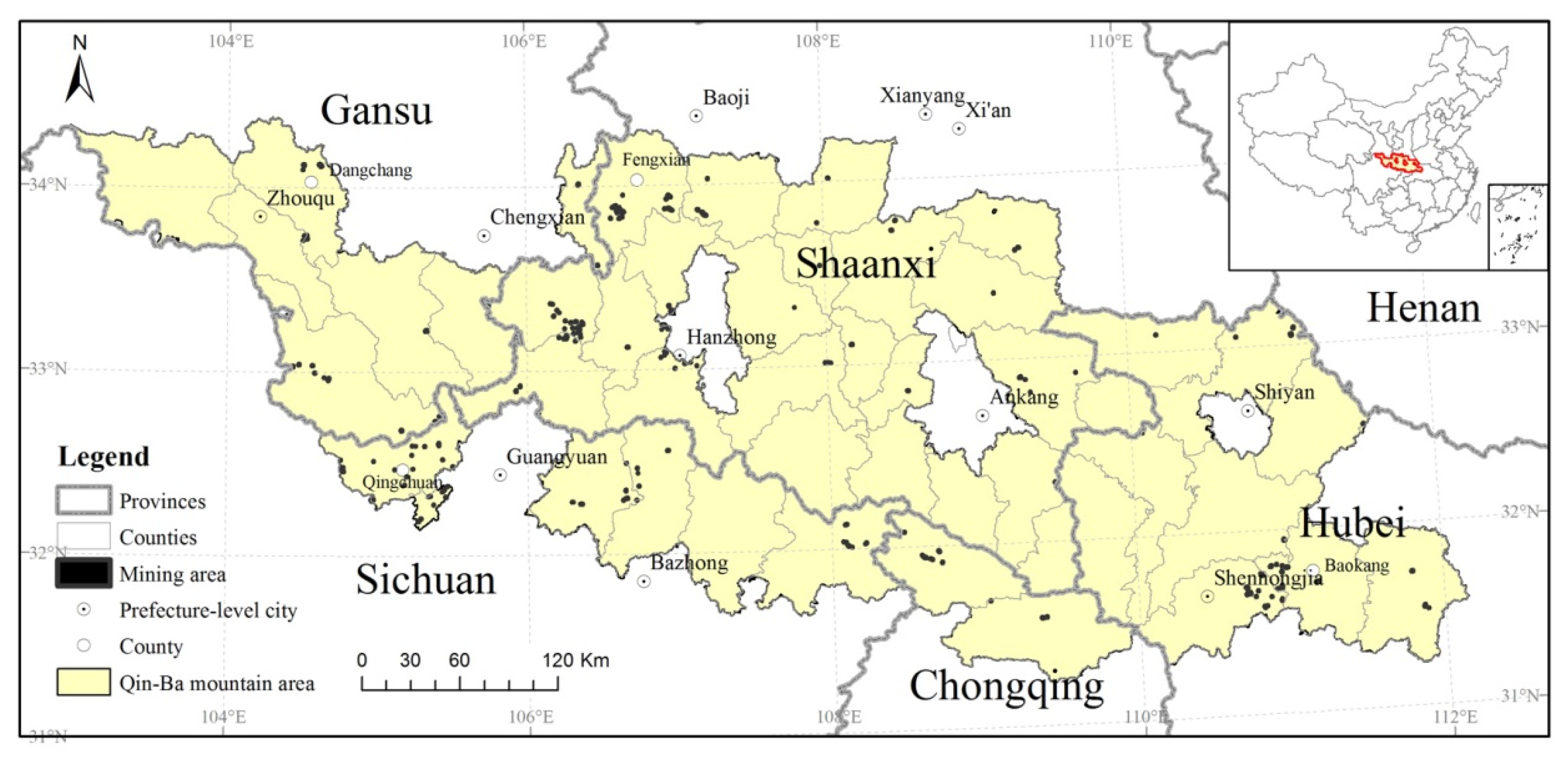
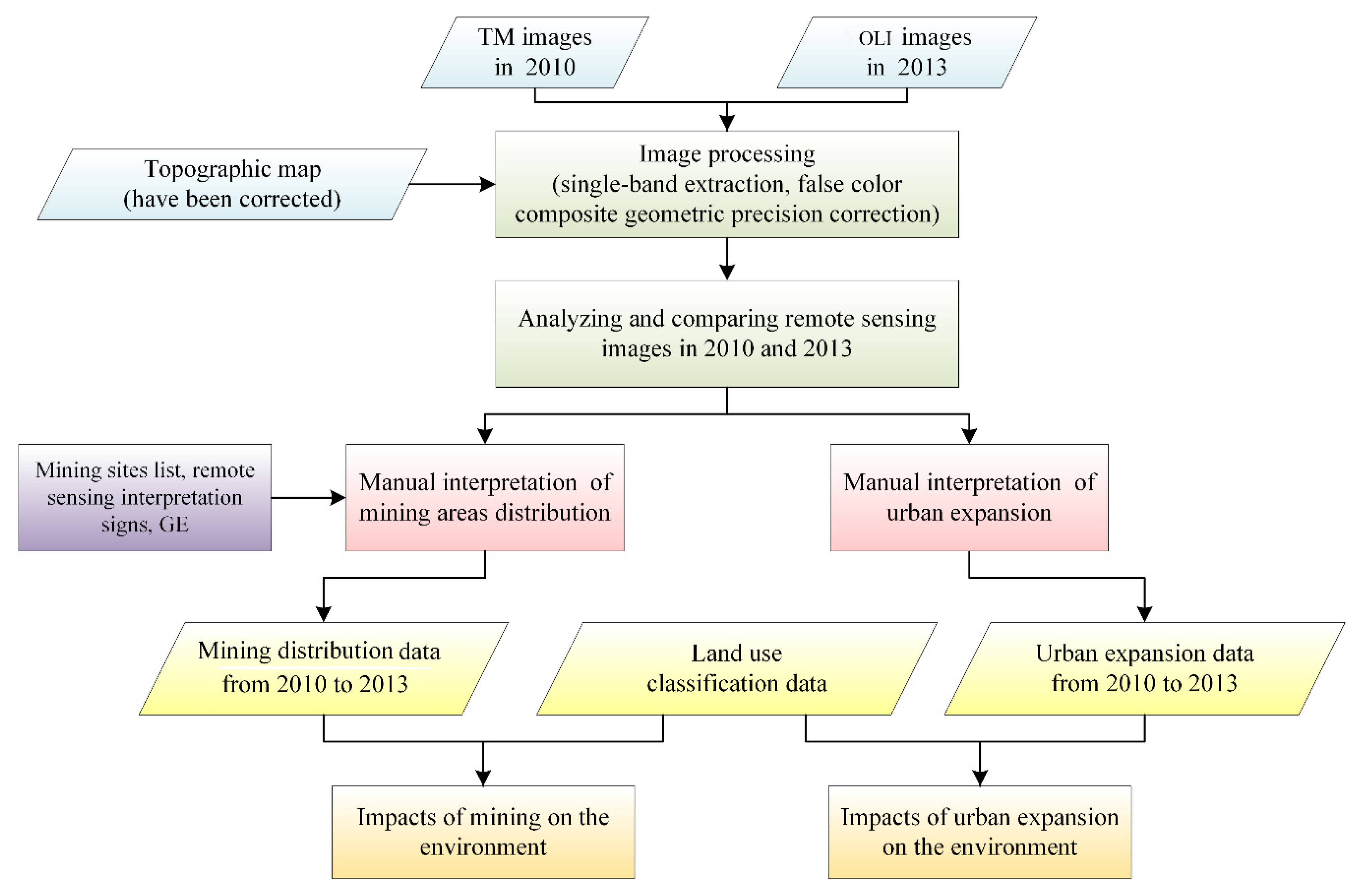

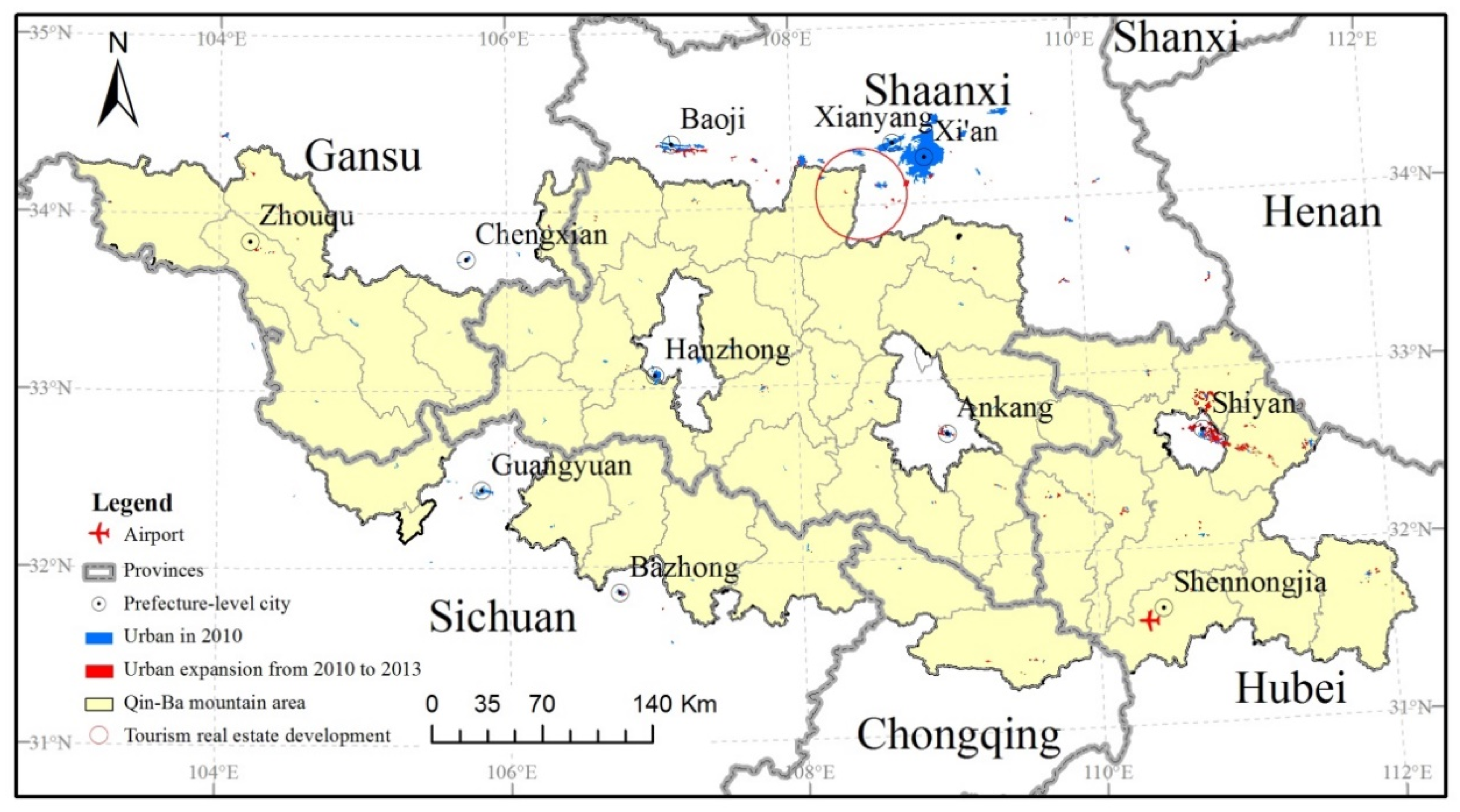
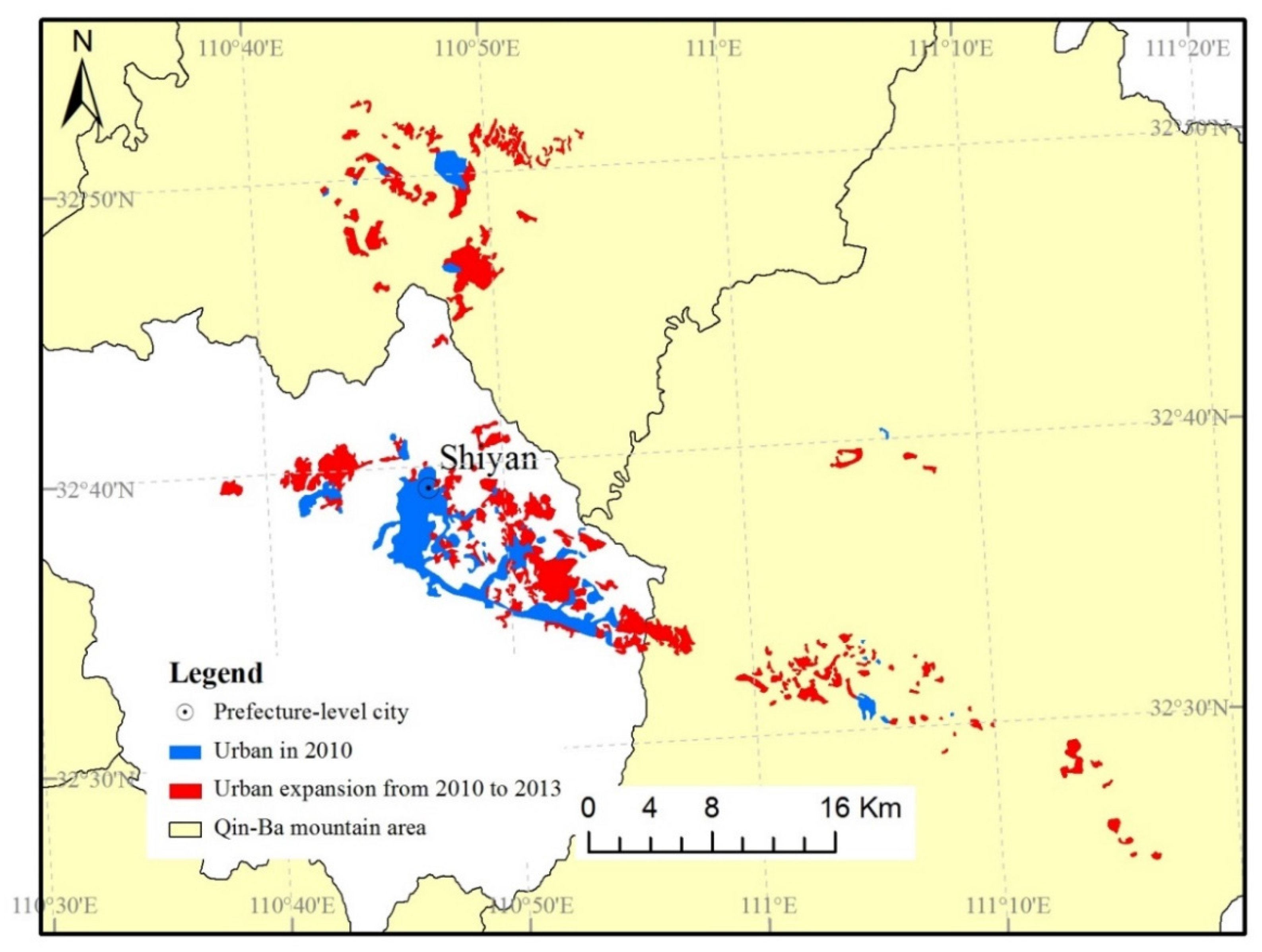
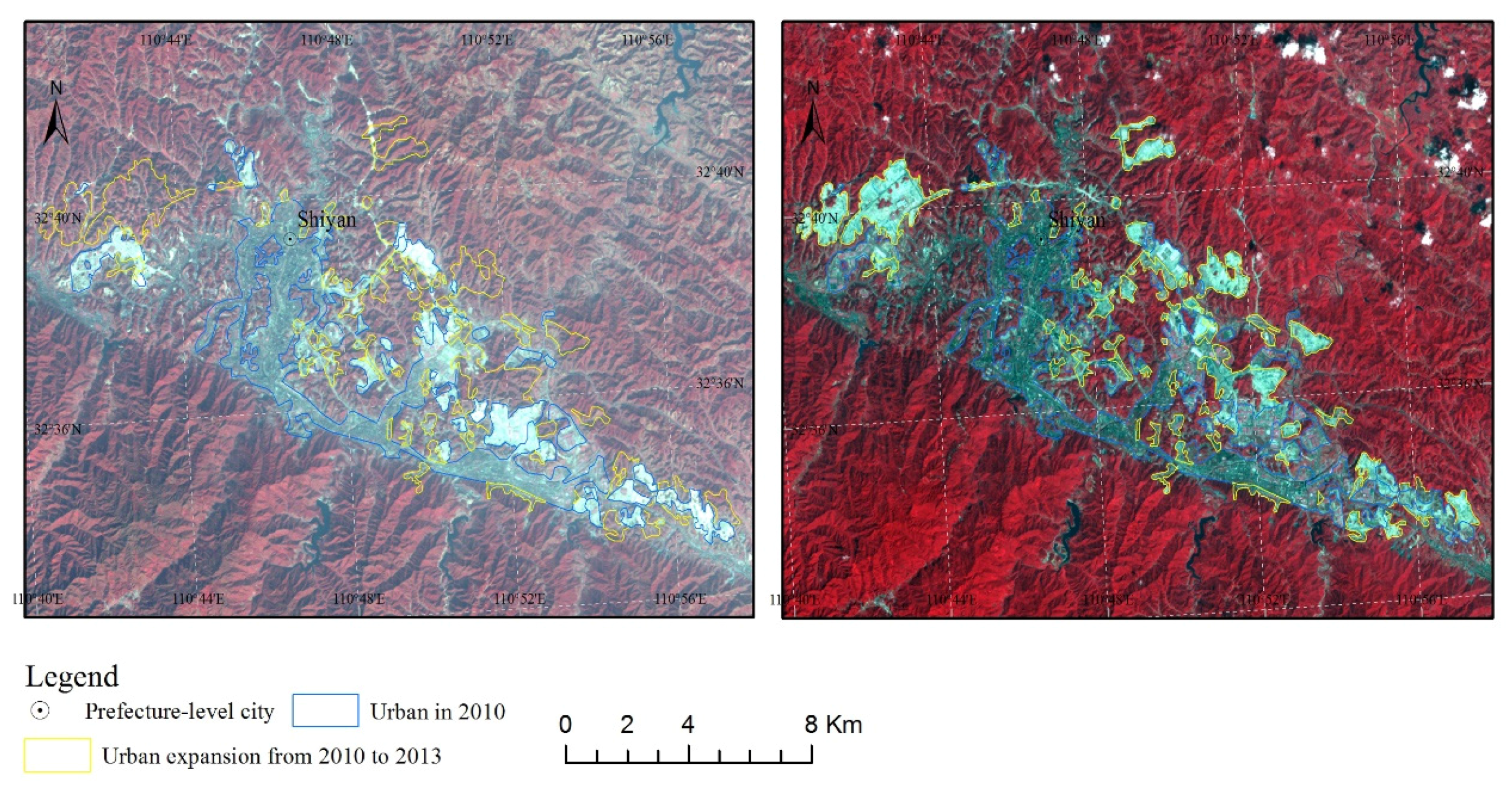

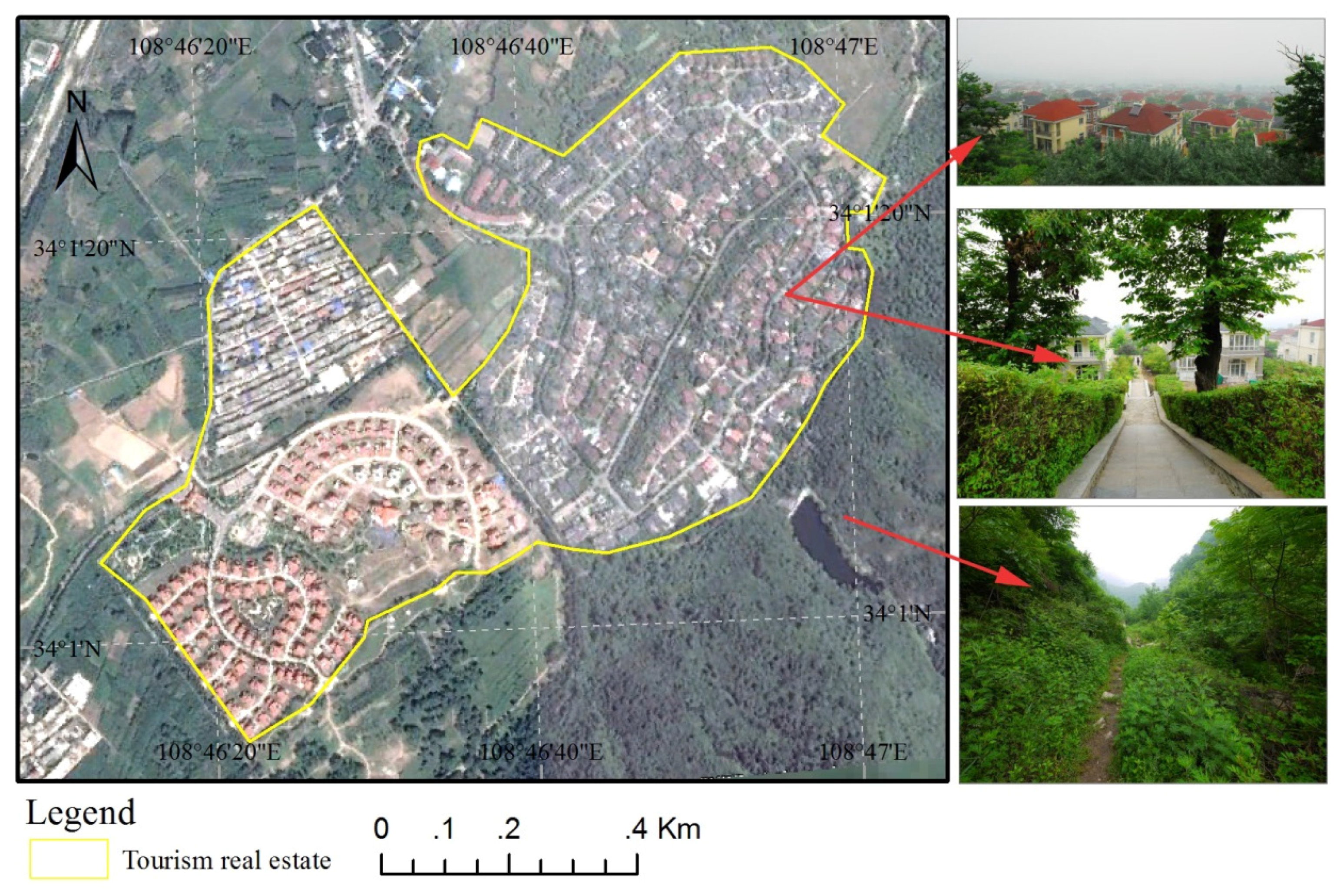
© 2016 by the authors; licensee MDPI, Basel, Switzerland. This article is an open access article distributed under the terms and conditions of the Creative Commons Attribution (CC-BY) license (http://creativecommons.org/licenses/by/4.0/).
Share and Cite
Xu, X.; Cai, H.; Sun, D.; Hu, L.; Banson, K.E. Impacts of Mining and Urbanization on the Qin-Ba Mountainous Environment, China. Sustainability 2016, 8, 488. https://doi.org/10.3390/su8050488
Xu X, Cai H, Sun D, Hu L, Banson KE. Impacts of Mining and Urbanization on the Qin-Ba Mountainous Environment, China. Sustainability. 2016; 8(5):488. https://doi.org/10.3390/su8050488
Chicago/Turabian StyleXu, Xinliang, Hongyan Cai, Daowei Sun, Lan Hu, and Kwamina E. Banson. 2016. "Impacts of Mining and Urbanization on the Qin-Ba Mountainous Environment, China" Sustainability 8, no. 5: 488. https://doi.org/10.3390/su8050488





